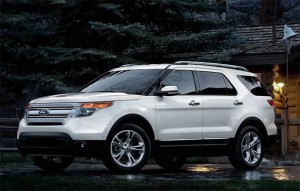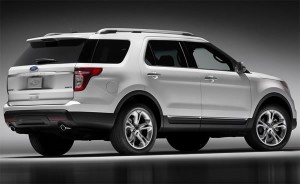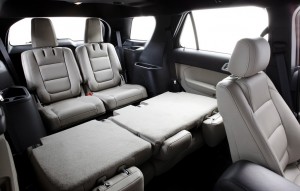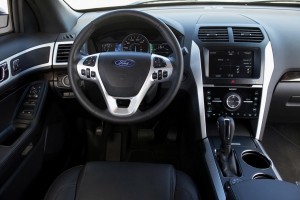Couch Living
Ford has succeeded by giving Americans what they want. Case in point, its F-Series remains the best-selling vehicle in a society long since divorced from the agrarian or even DIY roots which gave rise to the pickup truck. Ford’s highly successful Explorer has traded on a similar vibe, combining a measure of space and off-road utility with a rugged image.
With the new 2011 Explorer, Ford has responded to the chief market demand signals, recasting the Explorer as a crossover-ish SUV. In so doing it has produced a feature-rich, dynamically sedate, modest off-roader with the power, size and ride height to satisfy the ‘secure-feeling’ that buyers in the segment look for. It’s big, it’s shiny. It’s throw-pillow ready.
Ford emphasizes the Explorer’s new structure; “the strongest, lightest one yet, thanks to high tech materials and advanced forming technology” goes the brochure. Stiffer it is, but its origins point to its expected mission. The Explorer now rolls on a car chassis. Related to the Ford Freestyle platform, it gets an array of modifications found on the new Taurus and further developed including hydroformed front frame rails which improve crash-worthiness.
They translate to a mid-size crossover with a 112 inch wheelbase. (For comparison, Ford’s Flex crossover has a 117.9 inch wheelbase.) The ride and handling are assuredly more car-like than the previous body-on-frame design and Ford touts the Explorer’s better roll control. The suspension never exactly wallows but pitch and roll motions feel only “contained”. The Explorer responds slowly to most inputs with electrically-assisted steering distinguished by its lack of on-center feel and generally rubbery character.
The all-wheel drive XLT’s 3.5 liter V6 makes 290 hp and 255 lb.-ft. of torque, mated to a six-speed automatic transmission (a 2.0 liter Ecoboost turbo is also available). In a 4700 pound vehicle it’s enough power but putting your foot down yields a slow two-to-three gear downshift and eventual acceleration. A center console-mounted rotary drive mode selector a la Land Rover’s much copied control allows selection of mud/ruts, sand, and snow settings though it will invariably rest in “normal” day to day.
The Explorer XLT’s dynamic responses are consistent but dulled. Drive it for long enough and your control sensitivity fades. In Ford’s defense the Explorer has the kind of mash-the-throttle, spin-the-steering wheel, think about something else driving character that a large portion of the public favors. The ride is good but I find the experience rather like slumping on the couch after too much pizza and beer, bloated and listless.
That said, a gentlemen parked next to me asked if this was indeed the new Explorer then complimented its looks, especially its red candy metallic paint. The paint covers a soft -shouldered exterior and an interior with passenger volume (151.7 cu-ft.) and cargo volume (80.7 cu-ft behind 1st row) enough to put it mid-pack in a segment including the Chevy Traverse/GMC Acadia and Jeep Grand Cherokee among others. The XLT I tested came with comfortable (and likely durable) cloth seating and well cushioned front buckets. The driver’s seat power adjustments work well but result in a seat that is almost bound to sit higher than the passenger chair. The second row is roomy and the seat cushions are refreshingly high though a bit short. The third row is, as usual, a place for children.
The second and third rows fold flat but the result is a rather high cargo floor and high lift-in through the rear hatch. You’ll need a socket to remove the third row seats as well. A second row sunroof is available and retractable clothes hooks are a nice touch.
The Explorer’s dash instruments recall those on the Fusion and are highly configurable via two four-way controllers on the steering wheel. Vehicle information is displayed to the left of the analog speedometer and entertainment to the right. However both can take too much driver attention away from the road as different pages are selected and displayed. The same could be said for Ford’s Sync touch-screen display. There is simply a lot of information available and operating logic that dictates navigation to another page just to change the A/C or heat distribution from vents to vents/floor. Analog HVAC and other controls are via a touchpad interface below the screen. I nearly always needed two touches to actuate the function I wanted. The Sony audio system offers iTunes tagging and a host of other features, many of which can be accessed on the move.
The presentation reminds me a bit of using a multi-function remote from the couch, calling up a picture-within-picture display on my TV; watching the NBA finals while checking Facebook and Twitter, the weather stats in a small box at bottom-screen-right. All weirdly entertaining, over-stimulating, and definitely distracting.
But that’s what we’ve become, accustomed to satisfying our sedentary whims. Ford is simply addressing our wants. Funny thing is, those wants could be even better sated by Ford’s own Flex crossover with the same powerplant, fuel economy, nav/communications/entertainment offerings along with more interior space and a better driving character.
A look behind the second row seats summed up the Explorer for me. There is where you’ll find the flat tire provisions – a tire sealant and inflator kit. Yes, I know it’s about fuel economy (I saw 18 mpg)… Just inject the sealant and get back on the couch.
The Specs
Price as tested: $39,100
Engine: 290 hp, 3.5 liter V6
Curb Weight: 4695 pounds
Fuel Economy: 17 city/23 highway




Leave a Reply